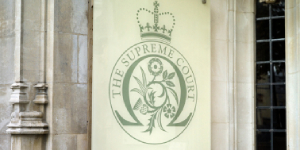
Eleanor Groves, Express Solicitors
By Eleanor Groves, Solicitor, OL/PL at Legal Futures Associate Express Solicitors
Since the start of my legal career, I have been developing my practice area which fell quite unexpectedly into claims against beauticians, aesthetics providers and even cosmetic surgeons.
While the area itself is interesting, people who are injured because of these procedures are particularly harmed when they go wrong.
The whole industry relies on people being unhappy about part of themselves. Whether it be the natural ageing process, hair colour, hair growth or their weight, I’m sure all those reading could think of one thing they would change if they could. Social media has magnified these insecurities with editing and plastic surgery being promoted by celebrities and influencers. The aesthetics industry has exploded over the last 10 years with new treatments being advertised constantly.
However, the increased availability means the number of these procedures going wrong is on the up too. Express Solicitors has expanded its cosmetics team from just one (me) to three people from July 2024.
In this toe dip into the issues of these types of injury claims being pursued and some of the issues with the industry, generally, we’ll see there are plenty of pitfalls but still some hope for the future.
A quick review of Westlaw shows claims that are beauty or cosmetics in nature have been around for a long time. However, with the pressures of social media, cheap procedures, ever-growing competition and the lack of regulation, the types of procedures causing injuries continues to increase. The growing number of beauty-based claims has brought this niche area back from being under the radar of APIL, with them reintroducing a conference on the topic in 2023 after 10 years.
Clinical dispute or PI?
A choice that will need to be undertaken at the outset of these claims is which of the Pre-Action Protocols should be used – a Clinical Dispute or Personal Injury (low value or otherwise).
There are arguments for both, and which one is used will be determined by the procedure being provided and the provider. A doctor/nurse/dentist then moves the matter to clinical dispute protocol. However, as I discuss below, many treatments will not be completed by one of these registered and qualified people.
In 2022, a costs appeal gave some guidance to this in respect of lasers which put emphasis on the healthcare provider aspect of the clinical dispute protocol.
Bolam is the applicable test. The proper and accepted practice is essential for determining whether a breach can be established in these cases. I’m sure most of the judiciary could not assess whether the consent form contained all the relevant risk/side effects such as, whether a patch test was necessary or the correct order for a wax and tint.
Breach evidence is almost always necessary in these cases, though this increases costs and the complexity of the case. However, in the era of the new complexity bandings, this could be the remedy to the issue of costs if your proceedings should be started by virtue of the PI Protocols instead of the Clinical Dispute Protocols.
In the past, judges have been complimentary of breach evidence in these cases and have further agreed that the principles set out by Bolam provide the relevant test to be considered.
Lack of insurance
Insurance is a major issue for a claimant pursuing a provider of beauty and aesthetic treatments. As shocking as it may seem, there is no legal requirement for beauticians/ aestheticians to hold insurance, even when they are injecting/breaking the skin. Insurance not only protects the customer but also the company’s assets (or the beautician’s assets if they are operating as a sole trader – personal assets may be available to the claimant enforcing a judgment).
Insurers not indemnifying for policy breaches.
For example, where a beautician fails to patch test (a clear breach of duty) the terms of their policies allow them to void it. The options available to claimants are them to sue the beautician directly or not proceed.
Claimants lose out when beauticians have tried to do the right thing.
Policy terms are usually very broad, such as “must follow manufacturer’s instructions”. Eyebrow and eyelash tints (professional and shop-bought) usually contain an instruction to patch test. PPD has long been known to cause allergic reactions. You may not be allergic to all hair dye/tints so a patch test must always be done.
Regular patch testing is also good practice. Hairdressers/eyebrow technicians should have good policies in place for regular testing. Not having a good practice in respect of this is also a breach of duty. A patch test once and no retesting will not pick up when people spontaneously become allergic to PPD or if they can the product used. This can also be an issue for eyelash technicians and glues used in their extensions.
Some defendants do not tell their insurance provider about a CNF or Letter of Claim thinking a claim will not proceed if there is no response. This may also be a policy breach, leaving them without insurance in the future if there are further claims and/or higher premiums.
Hairdressers are generally better at being insured and at patch testing but can also fall foul of poor standards. Common examples include allowing bleach to come into contact with the scalp, lack of burns protocols, or even being lulled into a false sense of security when a chemical burn occurs due to poor education.
Limited expert availability
Another issue is that there are always new procedures. This means that suitable experts are few and far between, causing issues for claimants trying to meet the burden required. Even well-established treatments/procedures such as ear piercing and tattoos have a lack of experts willing to provide reports. The industries are small and can be vindictive.
Unregulated industry
The industry itself is particularly unregulated. There is little to no legislation and recently implemented legislation is limited or slow-moving. There is also a degree of poor conduct in respect of prescriptions for Botox which regulation is meant to assist with. However, prescribers are simply signing off on prescriptions without ever seeing the patient.
As someone who sees the worst of the industry, poor practice occurs on most high streets and even on Harley Street itself – which once stood for an industry standard. I support the need for further regulation.
Save Face is a government-approved register of Medical Aesthetics providers. It provides comprehensive guides with advice about several procedures to help consumers make informed decisions and use providers that have been vetted. Some clinics will be registered with the CQC which will rate the quality of the clinic. The government’s justification for a lack of their own registers is that the procedures are elective.
A similar view is taken by GPs and hospitals when procedures go wrong. Claimants are often denied help when problems occur with filler and Botox due to the treatment being completed privately (usually at a very low price compared to the cost of private healthcare).
In 2022 the industry was considered to be worth £24.5 billion. In the same year, a new act was brought through Parliament and received royal assent. The Health and Care Act 2022 gives the government powers to introduce a licencing scheme for practitioners, however, it is unknown what this will look like. Secondary legislation will be needed to bring this into force.









